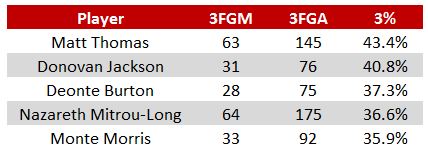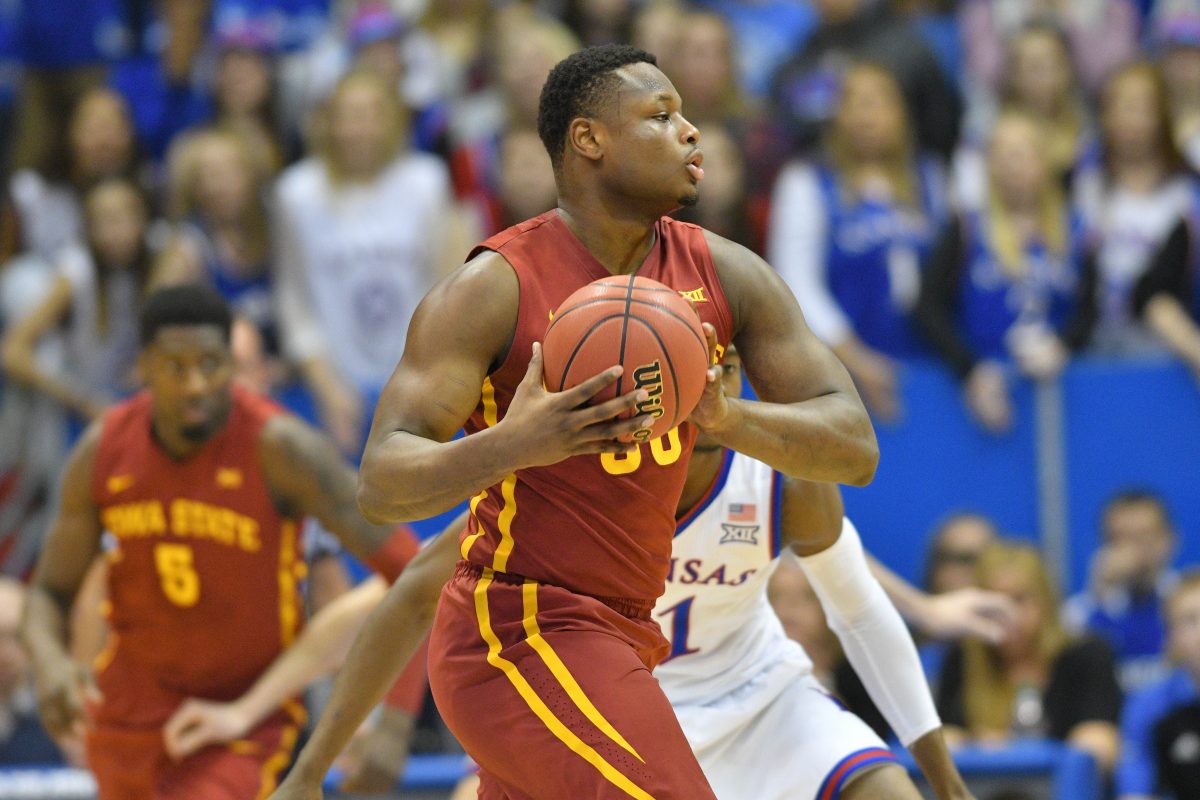Feb 4, 2017; Lawrence, KS, USA; Iowa State Cyclones guard Deonte Burton (30) passes the ball during the first half against the Kansas Jayhawks at Allen Fieldhouse. Mandatory Credit: Denny Medley-USA TODAY Sports
It has been a while since I have blabbered, at least in this forum, and while you probably thought you would be able to avoid me for the entire season, your luck finally ran out.
You were wrong.
So join me for a ride through the cavernous wonders of my mind and thoughts on Iowa State’s basketball season that have been pent up in my head.
One of the primary talking points of Iowa State’s season this year has been the offensive struggles this team has faced, relatively speaking of course. After all, on this Monday night the Cyclones are still ranked 38th in the KenPom.com adjusted offensive efficiencies (points per possession adjusted for strength of schedule and the home and away factors). Thirty-eighth is in the top 11 percent nationally but it is a drop from the top 20 or top 10 offenses that we have become accustomed to as Iowa State fans.
Most of the chatter surrounding the struggling offense has been centered on the deficiencies when forced to get a bucket with half-court offense when the defense has been set. That thought process is something that I am guilty of too.
Thanks to Synergy and my guy, Tom Danielson (on Twitter at @tom_danielson), I had some numbers available to try and find the truth.
The thinking started with the fact that Iowa State’s transition offense in the open court is when they are at their best and some numbers have even been discussed about having a higher scoring efficiency in transition (points per possession). But, any team should have a better scoring clip in transition if you just think about it logically. Transition shots are normally only taken with a number advantage and with more space to operate easier shots are had.
As of the morning of February 13, the Cyclones average 0.94 ppp with their half-court offense (the D1 average is 0.88) and 1.07 ppp with their transition offense (the D1 average is 1.04). But that alone doesn’t tell the whole story because of what I described in the preceding paragraph. Further, ISU’s half-court ranking is 54th in the country while the transition scoring is 118th.
To truly understand the reliance on transition scoring offense versus half-court, you need to look at the scoring margin between the two (or at least compare them to the D1 averages). For the Cyclones that is 0.131, which ranks 215th out of 351 D1 teams. Long story short, all things relative to each other, the Iowa State offense is better in the half-court when compared to its peers and they have less reliance on transition scoring.
The other noteworthy item here is that these numbers are not adjusted for strength of schedule. While Iowa State only ranks 54th in half-court scoring, they are 22nd among power six conference schools and only four schools ahead of Iowa State have played a tougher slate of opponent defenses (ISU is at 18th per KenPom.com). Of the top 25 power six conference half court offenses, the average strength of schedule of defensive opponents is 44.8.
The Long Ball
It was never a secret that the Cyclone offense was going to rely on the 3-point shot to make the offense work this season but that is becoming more and more evident as the season goes along. However, an easy argument can be made that the Cyclones are not taking enough 3-point shots.
Currently, 38.7 percent of Iowa State’s field goal attempts have been from outside the arc which is the 116th most in the country. On those shots, the Cyclones are cashing in 38.1 percent of the time (47th). Meanwhile, they are just the 117th best shooting team on attempts from inside the arc at 50.5 percent.
When you do all the math, a few key numbers come to the surface. First, on 2-point field goal attempts, the Cyclones are averaging 1.01 points per shot and on 3-point attempts they are averaging 1.14 points per shot. That alone illustrates why they need to launch from deep more often.
For the curious minds, for Iowa State to match its 3-point scoring prowess with 2-point attempts, the Cyclones would need to be making 2-pointers at a clip of 57.1 percent. That is 6.5 percentage points better than their current rate.
In other words, “keep chucking”.
To go with that, thanks in part to Deonte Burton’s surprising volume and success from beyond the 3-point line, the Cyclones have five guys that have attempted at least 75 shots from deep and all of them are hitting on at least 35 percent of those tries.

The only other times in Iowa State history to have four guys match those numbers and that happened last season with Georges Niang, Monte Morris, Matt Thomas, and Abdel Nader and the 2012-13 with Tyrus McGee, Korie Lucious, Chris Babb, and Niang. So yes, this team can shoot, needs to shoot more, and likely needs them to continue to fall at that rate to have a special ending to this season.
Simplifying the view of Deonte Burton
Deonte Burton has been the peculiar mystery throughout this season, some odd physical combination of Rahshon Clark, Royce White, and Georges Niang with the questionable and erratic decision making of Mike Taylor. Sometimes he is a hybrid of their best components and at other times, the exact opposite.
Typically, if a player makes a good decision, he gets a good result and if a player makes a poor decision he gets a poor result. More than any other player in the history of my experience with basketball, Burton is capable of terrible results when he makes good decisions and great results with horrendous decisions.
The most curious part of me trying to sum up his season comes when I look at his offensive rating (an all-encompassing but somewhat complex metric). On the surface, last year Burton had an offensive rating of 113 with a lower volume and better percentage from beyond the 3-point line and a slightly better turnover rate. That was with a slightly lower usage rate (essentially a measure of the number of offensive possessions that end with a player when they’re on the court) all while his minute percentage has doubled this year. The biggest difference to me is that last season Burton made 55 percent of his 2-point shots and this year that has dipped to 45 percent.
Obviously, the looks he’s getting this year are different without Niang and he’s being asked to create more for himself and his teammates but he also seems to be settling for jump shots more frequently.
Burton’s current offensive rating this season has dipped down to below 96. I was curious so I arbitrarily changed his 2-point field goal percentage for this season’s attempts to see how big of an impact it had on his offensive rating. If he were connecting on 50 percent of his shots inside the arc, his rating jumps to just below 101. If you change it to match his shooting from last season, it gets up to nearly 106.
That is still well below the 113 from last season but it wouldn’t be a completely shocking drop considering his increased role. Every player has a drop off point somewhere as usage goes up, it is just a matter of where and how far.
Deonte Burton isn’t as far off as he seems despite some of the glaring things we see that can be so completely frustrating. Even more than being completely frustrating, he is completely needed for the Cyclones to make waves this March.





